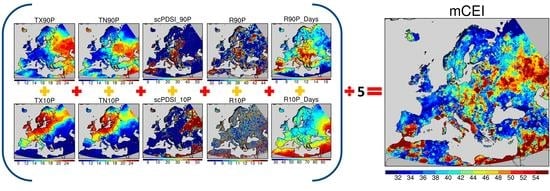Exposure Assessment of Climate Extremes over the Europe–Mediterranean Region
Abstract
1. Introduction
2. Data and Method
2.1. Data
2.2. Climate Extremes Index
3. Results and Discussion
3.1. Climatology of the Extreme Indexes Composing mCEI
3.2. Changes in the Extreme Indexes: Spatial and Temporal Analyses
3.3. Modified Climate Extremes Index (mCEI): Analyses of Climatology, Decadal Anomalies, and Extreme Years
3.4. Countries and Cities Exposed to mCEI
4. Conclusions
Author Contributions
Funding
Institutional Review Board Statement
Informed Consent Statement
Data Availability Statement
Conflicts of Interest
References
- Pachauri, R.K.; Mayer, L. (Eds.) Climate Change 2014: Synthesis Report; Intergovernmental Panel on Climate Change: Geneva, Switzerland, 2014; ISBN 978-92-9169-143-2. [Google Scholar]
- Seneviratne, S.I.; Nicholls, N.; Easterling, D.; Goodess, C.M.; Kanae, S.; Kossin, J.; Luo, Y.; Marengo, J.; McInnes, K.; Rahimi, M.; et al. Changes in Climate Extremes and their Impacts on the Natural Physical Environment. In Managing the Risks of Extreme Events and Disasters to Advance Climate Change Adaptation; Field, C.B., Barros, V., Stocker, T.F., Dahe, Q., Eds.; Cambridge University Press: Cambridge, UK, 2012; pp. 109–230. ISBN 978-1-139-17724-5. [Google Scholar]
- Alexander, L.V.; Zhang, X.; Peterson, T.C.; Caesar, J.; Gleason, B.; Klein Tank, A.M.G.; Haylock, M.; Collins, D.; Trewin, B.; Rahimzadeh, F.; et al. Global observed changes in daily climate extremes of temperature and precipitation. J. Geophys. Res. 2006, 111, D05109. [Google Scholar] [CrossRef]
- Donat, M.G.; Alexander, L.V.; Yang, H.; Durre, I.; Vose, R.; Dunn, R.J.H.; Willett, K.M.; Aguilar, E.; Brunet, M.; Caesar, J.; et al. Updated analyses of temperature and precipitation extreme indices since the beginning of the twentieth century: The HadEX2 dataset. J. Geophys. Res. Atmos. 2013, 118, 2098–2118. [Google Scholar] [CrossRef]
- Frich, P.; Alexander, L.V.; Gleason, B.; Haylock, M.; Tank, A.M.G.K.; Peterson, T. Observed coherent changes in climatic extremes during the second half of the twentieth century. Clim. Res. 2002, 19, 193–212. [Google Scholar] [CrossRef]
- Klein Tank, A.M.G.; Können, G.P. Trends in Indices of Daily Temperature and Precipitation Extremes in Europe, 1946–99. J. Clim. 2003, 16, 3665–3680. [Google Scholar] [CrossRef]
- Moberg, A.; Jones, P.D.; Lister, D.; Walther, A.; Brunet, M.; Jacobeit, J.; Alexander, L.V.; Della-Marta, P.M.; Luterbacher, J.; Yiou, P.; et al. Indices for daily temperature and precipitation extremes in Europe analyzed for the period 1901–2000. J. Geophys. Res. 2006, 111, D22106. [Google Scholar] [CrossRef]
- Klein Tank, A.M.G.; Peterson, T.C.; Quadir, D.A.; Dorji, S.; Zou, X.; Tang, H.; Santhosh, K.; Joshi, U.R.; Jaswal, A.K.; Kolli, R.K.; et al. Changes in daily temperature and precipitation extremes in central and south Asia. J. Geophys. Res. 2006, 111, D16105. [Google Scholar] [CrossRef]
- You, Q.; Kang, S.; Aguilar, E.; Yan, Y. Changes in daily climate extremes in the eastern and central Tibetan Plateau during 1961–2005. J. Geophys. Res. 2008, 113, D07101. [Google Scholar] [CrossRef]
- Peterson, T.C.; Zhang, X.; Brunet-India, M.; Vázquez-Aguirre, J.L. Changes in North American extremes derived from daily weather data. J. Geophys. Res. 2008, 113, D07113. [Google Scholar] [CrossRef]
- Alexander, L.V.; Hope, P.; Collins, D.; Trewin, B.; Lynch, A.; Nicholls, N. Trends in Australia’s climate means and extremes: A global context. Aust. Meteorol. Mag. 2007, 56, 1–18. [Google Scholar]
- Aguilar, E.; Peterson, T.C.; Obando, P.R.; Frutos, R.; Retana, J.A.; Solera, M.; Soley, J.; García, I.G.; Araujo, R.M.; Santos, A.R.; et al. Changes in precipitation and temperature extremes in Central America and northern South America, 1961–2003. J. Geophys. Res. 2005, 110, D23107. [Google Scholar] [CrossRef]
- Vincent, L.A.; Peterson, T.C.; Barros, V.R.; Marino, M.B.; Rusticucci, M.; Carrasco, G.; Ramirez, E.; Alves, L.M.; Ambrizzi, T.; Berlato, M.A.; et al. Observed Trends in Indices of Daily Temperature Extremes in South America 1960–2000. J. Clim. 2005, 18, 5011–5023. [Google Scholar] [CrossRef]
- Zhang, X.; Aguilar, E.; Sensoy, S.; Melkonyan, H.; Tagiyeva, U.; Ahmed, N.; Kutaladze, N.; Rahimzadeh, F.; Taghipour, A.; Hantosh, T.H.; et al. Trends in Middle East climate extreme indices from 1950 to 2003. J. Geophys. Res. 2005, 110, D22104. [Google Scholar] [CrossRef]
- Kostopoulou, E.; Jones, P.D. Assessment of climate extremes in the Eastern Mediterranean. Meteorol. Atmospheric Phys. 2005, 89, 69–85. [Google Scholar] [CrossRef]
- Dai, A. Drought under global warming: A review. Wiley Interdiscip. Rev. Clim. Chang. 2011, 2, 45–65. [Google Scholar] [CrossRef]
- Zhang, X.; Alexander, L.; Hegerl, G.C.; Jones, P.; Tank, A.K.; Peterson, T.C.; Trewin, B.; Zwiers, F.W. Indices for monitoring changes in extremes based on daily temperature and precipitation data. Wiley Interdiscip. Rev. Clim. Chang. 2011, 2, 851–870. [Google Scholar] [CrossRef]
- Karl, T.R.; Knight, R.W.; Easterling, D.R.; Quayle, R.G. Indices of Climate Change for the United States. Bull. Am. Meteorol. Soc. 1996, 77, 279–292. [Google Scholar] [CrossRef]
- Palmer, W.C. Meteorological Drought; Research Paper No. 45; U.S. Department of Commerce: Washington, DC, USA, 1965.
- Gleason, K.L.; Lawrimore, J.H.; Levinson, D.H.; Karl, T.R.; Karoly, D.J. A Revised U.S. Climate Extremes Index. J. Clim. 2008, 21, 2124–2137. [Google Scholar] [CrossRef]
- Gallant, A.J.E.; Karoly, D.J.; Gleason, K.L. Consistent Trends in a Modified Climate Extremes Index in the United States, Europe, and Australia. J. Clim. 2014, 27, 1379–1394. [Google Scholar] [CrossRef]
- Dittus, A.J.; Karoly, D.J.; Lewis, S.C.; Alexander, L.V. A Multiregion Assessment of Observed Changes in the Areal Extent of Temperature and Precipitation Extremes. J. Clim. 2015, 28, 9206–9220. [Google Scholar] [CrossRef]
- Dittus, A.J.; Karoly, D.J.; Lewis, S.C.; Alexander, L.V.; Donat, M.G. A Multiregion Model Evaluation and Attribution Study of Historical Changes in the Area Affected by Temperature and Precipitation Extremes. J. Clim. 2016, 29, 8285–8299. [Google Scholar] [CrossRef]
- Batibeniz, F.; Ashfaq, M.; Diffenbaugh, N.S.; Key, K.; Evans, K.J.; Turuncoglu, U.U.; Önol, B. Doubling of U.S. Population Exposure to Climate Extremes by 2050. Earths Future 2020, 8. [Google Scholar] [CrossRef]
- Gallant, A.J.E.; Karoly, D.J. A Combined Climate Extremes Index for the Australian Region. J. Clim. 2010, 23, 6153–6165. [Google Scholar] [CrossRef]
- Lange, S.; Volkholz, J.; Geiger, T.; Zhao, F.; Vega, I.; Veldkamp, T.; Reyer, C.P.O.; Warszawski, L.; Huber, V.; Jägermeyr, J.; et al. Projecting Exposure to Extreme Climate Impact Events Across Six Event Categories and Three Spatial Scales. Earths Future 2020, 8. [Google Scholar] [CrossRef]
- Mora, C.; Spirandelli, D.; Franklin, E.C.; Lynham, J.; Kantar, M.B.; Miles, W.; Smith, C.Z.; Freel, K.; Moy, J.; Louis, L.V.; et al. Broad threat to humanity from cumulative climate hazards intensified by greenhouse gas emissions. Nat. Clim. Chang. 2018, 8, 1062–1071. [Google Scholar] [CrossRef]
- Ridder, N.N.; Pitman, A.J.; Ukkola, A.M. Do CMIP6 Climate Models Simulate Global or Regional Compound Events Skillfully? Geophys. Res. Lett. 2021, 48. [Google Scholar] [CrossRef]
- Forzieri, G.; Feyen, L.; Russo, S.; Vousdoukas, M.; Alfieri, L.; Outten, S.; Migliavacca, M.; Bianchi, A.; Rojas, R.; Cid, A. Multi-hazard assessment in Europe under climate change. Clim. Chang. 2016, 137, 105–119. [Google Scholar] [CrossRef]
- Lung, T.; Lavalle, C.; Hiederer, R.; Dosio, A.; Bouwer, L.M. A multi-hazard regional level impact assessment for Europe combining indicators of climatic and non-climatic change. Glob. Environ. Chang. 2013, 23, 522–536. [Google Scholar] [CrossRef]
- Vitolo, C.; Di Napoli, C.; Di Giuseppe, F.; Cloke, H.L.; Pappenberger, F. Mapping combined wildfire and heat stress hazards to improve evidence-based decision making. Environ. Int. 2019, 127, 21–34. [Google Scholar] [CrossRef]
- Kumar, N.; Kumar Goyal, M.; Kumar Gupta, A.; Jha, S.; Das, J.; Madramootoo, C.A. Joint behaviour of climate extremes across India: Past and future. J. Hydrol. 2021, 597, 126185. [Google Scholar] [CrossRef]
- Das, S.; Ghosh, A.; Hazra, S.; Ghosh, T.; Safra de Campos, R.; Samanta, S. Linking IPCC AR4 & AR5 frameworks for assessing vulnerability and risk to climate change in the Indian Bengal Delta. Prog. Disaster Sci. 2020, 7, 100110. [Google Scholar] [CrossRef]
- ERA5: Fifth Generation of ECMWF Atmospheric Reanalyses of the Global Climate. Available online: https://cds.climate.copernicus.eu/cdsapp#!/home (accessed on 22 January 2019).
- Beck, H.E.; Wood, E.F.; Pan, M.; Fisher, C.K.; Miralles, D.G.; van Dijk, A.I.J.M.; McVicar, T.R.; Adler, R.F. MSWEP V2 Global 3-Hourly 0.1° Precipitation: Methodology and Quantitative Assessment. Bull. Am. Meteorol. Soc. 2019, 100, 473–500. [Google Scholar] [CrossRef]
- Wells, N.; Goddard, S.; Hayes, M.J. A Self-Calibrating Palmer Drought Severity Index. J. Clim. 2004, 17, 17. [Google Scholar] [CrossRef]
- Webb, R.S.; Rosenzweig, C.E.; Levine, E.R. Specifying land surface characteristics in general circulation models: Soil profile data set and derived water-holding capacities. Glob. Biogeochem. Cycles 1993, 7, 97–108. [Google Scholar] [CrossRef]
- Thornthwaite, C.W. An Approach toward a Rational Classification of Climate. Geogr. Rev. 1948, 38, 55. [Google Scholar] [CrossRef]
- Pesaresi, M.; Florczyk, A.; Schiavina, M.; Melchiorri, M.; Maffenini, L. GHS settlement grid, updated and refined REGIO model 2014 in application to GHS-BUILT R2018A and GHS-POP R2019A, multitemporal (1975–1990–2000–2015), R2019A. Jt. Res. Cent. Data Cat. 2019. [Google Scholar] [CrossRef]
- Florczyk, A.J.; Corbane, C.; Ehrlich, D.; Freire, S.; Kemper, T.; Maffenini, L.; Melchiorri, L.; Pesaresi, L.; Politis, P.; Schiavina, M.; et al. GHSL Data Package 2019; Publications Office of the European Union: Luxembourg, 2019; ISBN 978-92-76-13186-1. [Google Scholar]
- U.S. Climate Extremes Index (CEI). Available online: https://www.ncdc.noaa.gov/extremes/cei (accessed on 18 November 2019).
- Bador, M.; Alexander, L.V.; Contractor, S.; Roca, R. Diverse estimates of annual maxima daily precipitation in 22 state-of-the-art quasi-global land observation datasets. Environ. Res. Lett. 2020, 15, 035005. [Google Scholar] [CrossRef]
- Fleig, A.K.; Tallaksen, L.M.; Hisdal, H.; Hannah, D.M. Regional hydrological drought in north-western Europe: Linking a new Regional Drought Area Index with weather types. Hydrol. Process. 2011, 25, 1163–1179. [Google Scholar] [CrossRef]
- Spinoni, J.; Naumann, G.; Vogt, J.V.; Barbosa, P. The biggest drought events in Europe from 1950 to 2012. J. Hydrol. Reg. Stud. 2015, 3, 509–524. [Google Scholar] [CrossRef]
- Serreze, M.C.; Stroeve, J. Arctic sea ice trends, variability and implications for seasonal ice forecasting. Philos. Trans. R. Soc. Math. Phys. Eng. Sci. 2015, 373, 20140159. [Google Scholar] [CrossRef]
- Cohen, J.; Screen, J.A.; Furtado, J.C.; Barlow, M.; Whittleston, D.; Coumou, D.; Francis, J.; Dethloff, K.; Entekhabi, D.; Overland, J.; et al. Recent Arctic amplification and extreme mid-latitude weather. Nat. Geosci. 2014, 7, 627–637. [Google Scholar] [CrossRef]
- Overland, J.E.; Wang, M. Recent Extreme Arctic Temperatures are due to a Split Polar Vortex. J. Clim. 2016, 29, 5609–5616. [Google Scholar] [CrossRef]
- Donat, M.G.; Alexander, L.V.; Herold, N.; Dittus, A.J. Temperature and precipitation extremes in century-long gridded observations, reanalyses, and atmospheric model simulations. J. Geophys. Res. Atmos. 2016, 121, 11174–11189. [Google Scholar] [CrossRef]
- Dittus, A.J.; Karoly, D.J.; Donat, M.G.; Lewis, S.C.; Alexander, L.V. Understanding the role of sea surface temperature-forcing for variability in global temperature and precipitation extremes. Weather Clim. Extrem. 2018, 21, 1–9. [Google Scholar] [CrossRef]
- Suursaar, Ü. Combined impact of summer heat waves and coastal upwelling in the Baltic Sea. Oceanologia 2020, 62, 511–524. [Google Scholar] [CrossRef]
- Fennessy, M.J.; Kinter, J.L. Climatic Feedbacks during the 2003 European Heat Wave. J. Clim. 2011, 24, 5953–5967. [Google Scholar] [CrossRef]
- Schär, C.; Vidale, P.L.; Lüthi, D.; Frei, C.; Häberli, C.; Liniger, M.A.; Appenzeller, C. The role of increasing temperature variability in European summer heatwaves. Nature 2004, 427, 332–336. [Google Scholar] [CrossRef]
- Spensberger, C.; Madonna, E.; Boettcher, M.; Grams, C.M.; Papritz, L.; Quinting, J.F.; Röthlisberger, M.; Sprenger, M.; Zschenderlein, P. Dynamics of concurrent and sequential Central European and Scandinavian heatwaves. Q. J. R. Meteorol. Soc. 2020, 146, 2998–3013. [Google Scholar] [CrossRef]
- Cattiaux, J.; Vautard, R.; Cassou, C.; Yiou, P.; Masson-Delmotte, V.; Codron, F. Winter 2010 in Europe: A cold extreme in a warming climate. Geophys. Res. Lett. 2010, 37. [Google Scholar] [CrossRef]
- Dole, R.; Hoerling, M.; Perlwitz, J.; Eischeid, J.; Pegion, P.; Zhang, T.; Quan, X.-W.; Xu, T.; Murray, D. Was there a basis for anticipating the 2010 Russian heat wave? Geophys. Res. Lett. 2011, 38. [Google Scholar] [CrossRef]
- Lau, W.K.M.; Kim, K.-M. The 2010 Pakistan Flood and Russian Heat Wave: Teleconnection of Hydrometeorological Extremes. J. Hydrometeorol. 2012, 13, 392–403. [Google Scholar] [CrossRef]
- Matsueda, M. Predictability of Euro-Russian blocking in summer of 2010. Geophys. Res. Lett. 2011, 38. [Google Scholar] [CrossRef]
- Trenberth, K.E.; Fasullo, J.T. Climate extremes and climate change: The Russian heat wave and other climate extremes of 2010. J. Geophys. Res. Atmos. 2012, 117. [Google Scholar] [CrossRef]
- Kotzeva, M.M.; Brandmüller, T.; Lupu, I.; Önnerfors, Å.; Corselli-Nordblad, L.; Coyette, C.; Johansson, A.; Strandell, H.; Wolff, P.; Europäische, K. (Eds.) Urban Europe: Statistics on Cities, Towns and Suburbs, 2016 ed.; Statistical Books/Eurostat; Publications Office of the European Union: Luxembourg, 2016; ISBN 978-92-79-60139-2. [Google Scholar]
- United Nations, Department of Economic and Social Affairs, Population Division. World Urbanization Prospects: The 2018 Revision (ST/ESA/SER.A/420); United Nations: New York, NY, USA, 2019; ISBN 978-92-1-004314-4. [Google Scholar]
- United Nations, Department of Economic and Social Affairs, Population Division. World Urbanization Prospects: The 2018 Revision, Online Edition. Available online: https://population.un.org/wup/Download/Files/WUP2018-F22-Cities_Over_300K_Annual.xls (accessed on 4 October 2019).


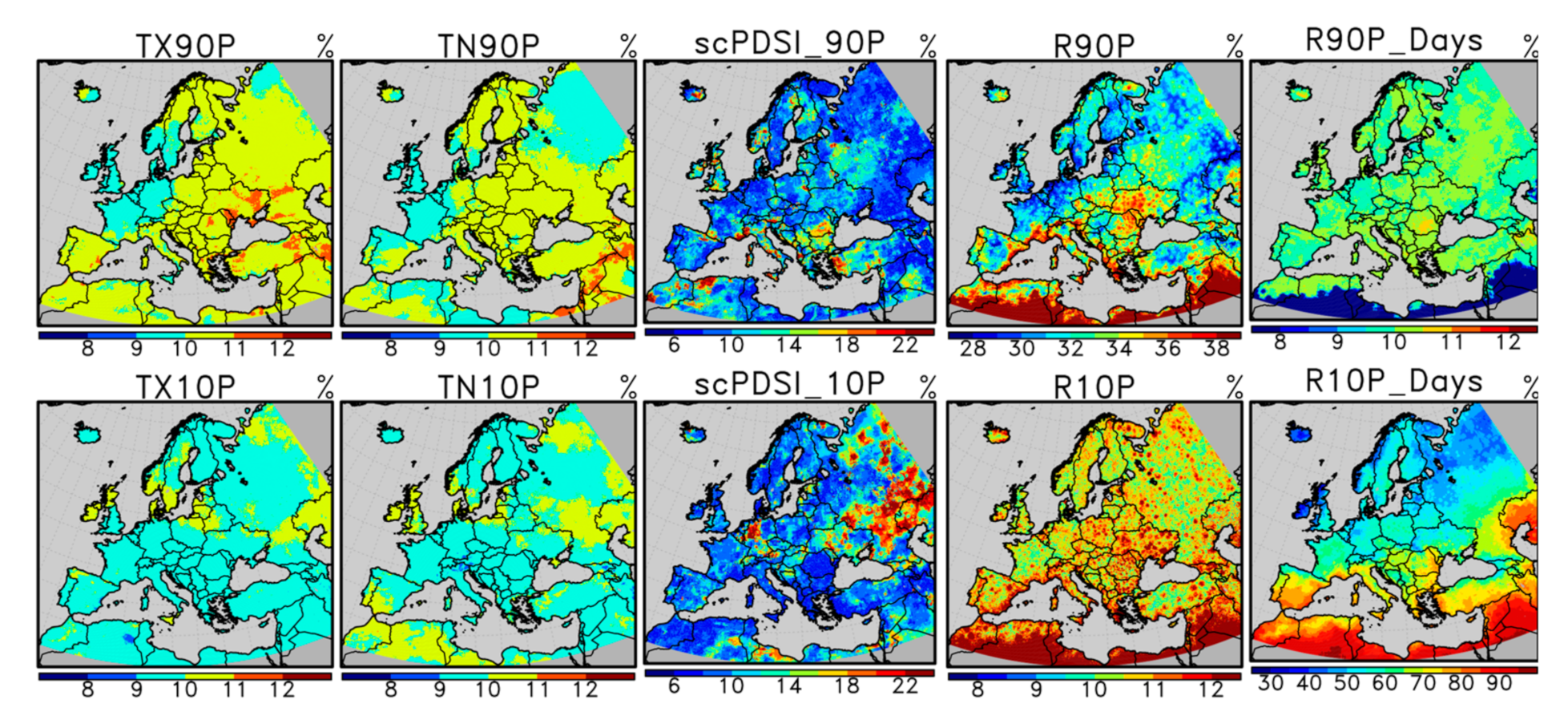


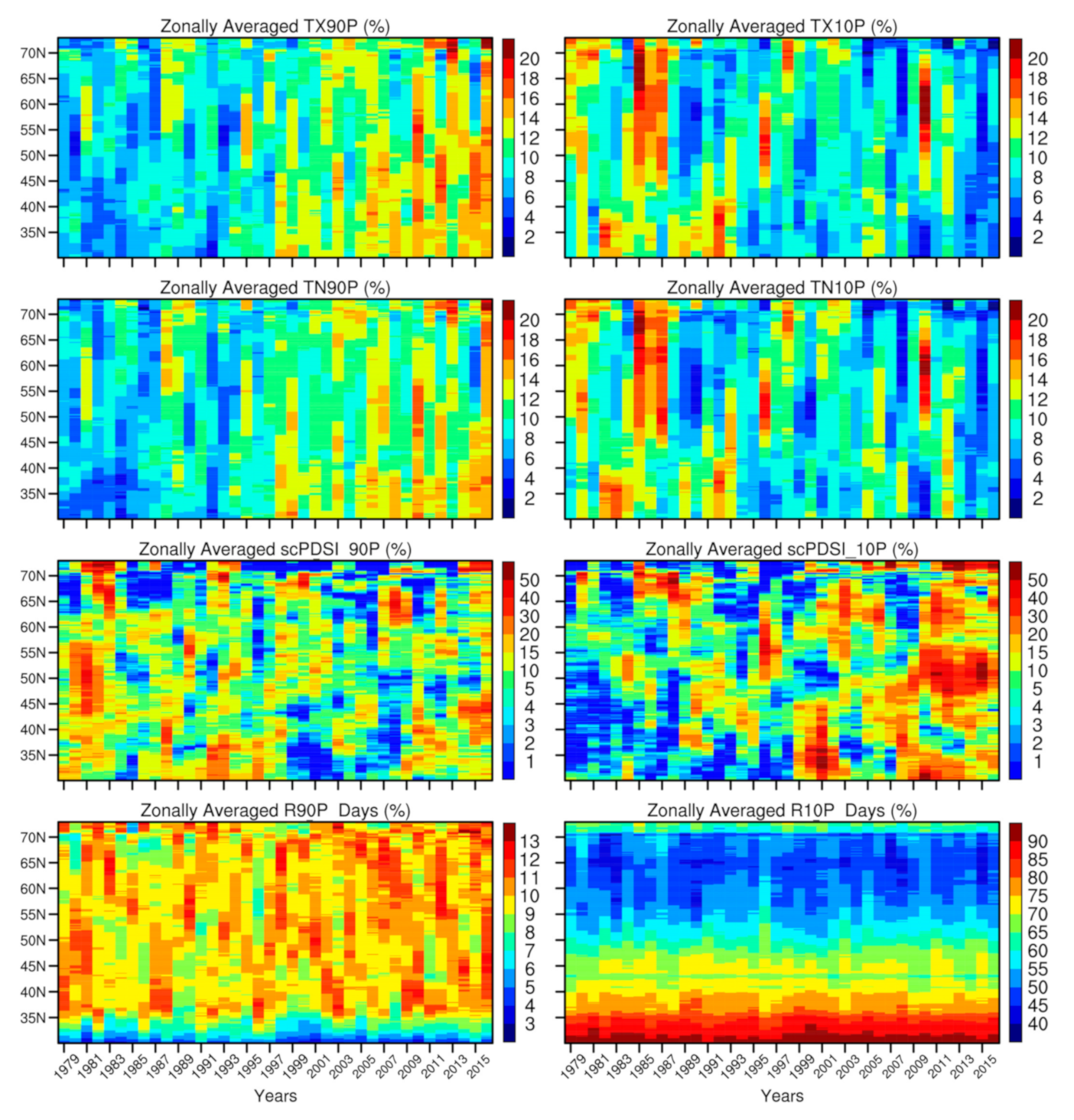
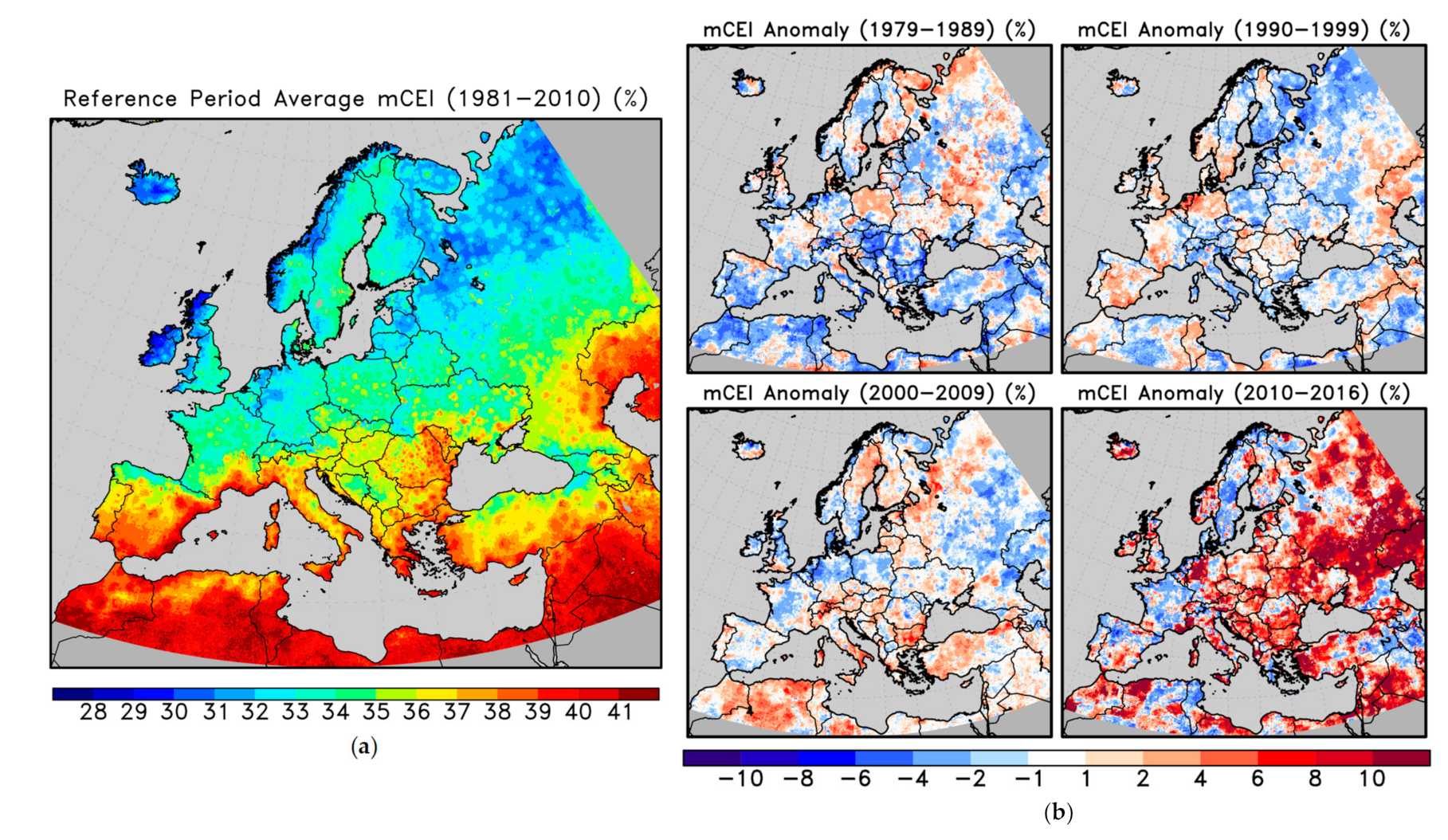
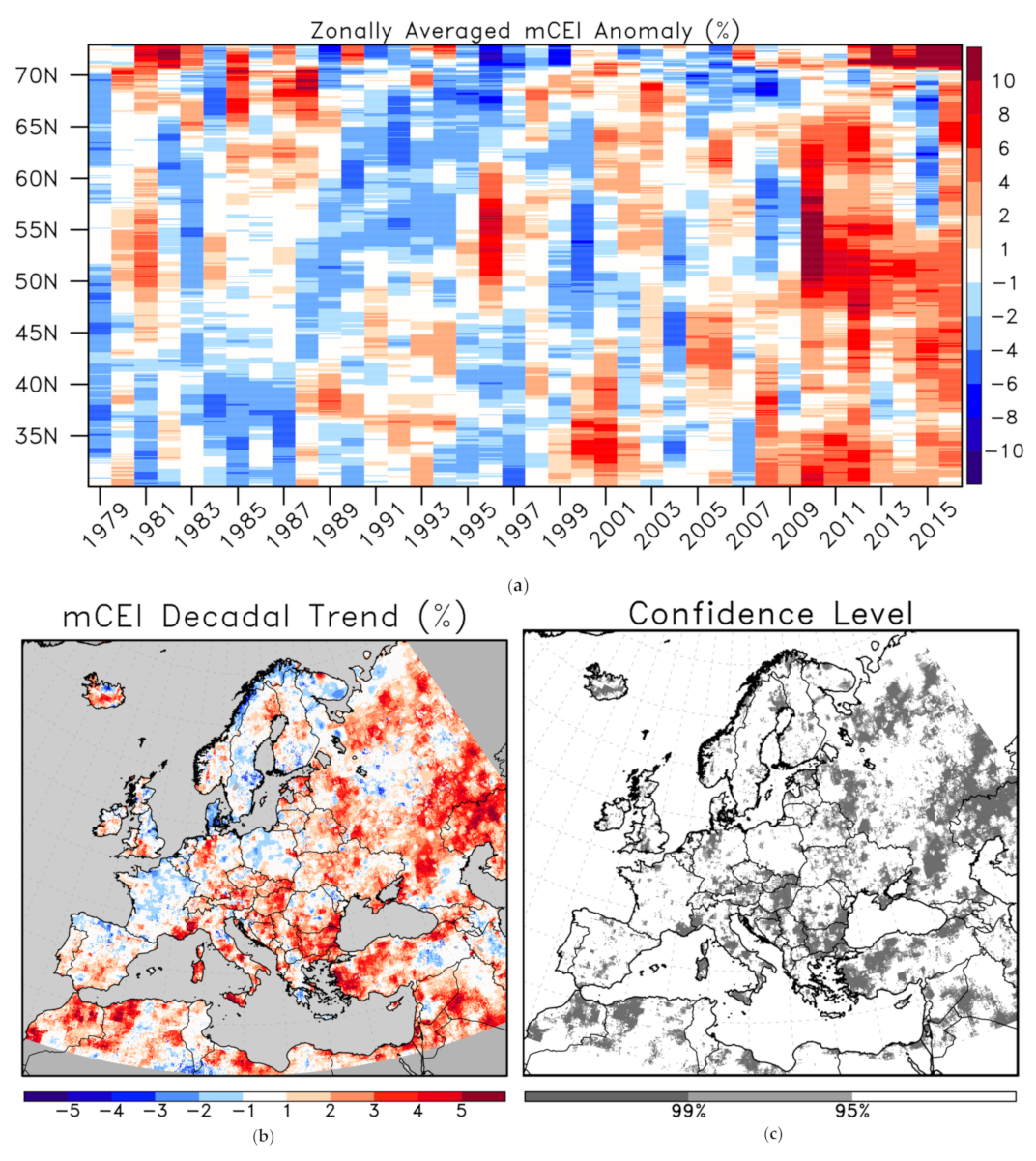
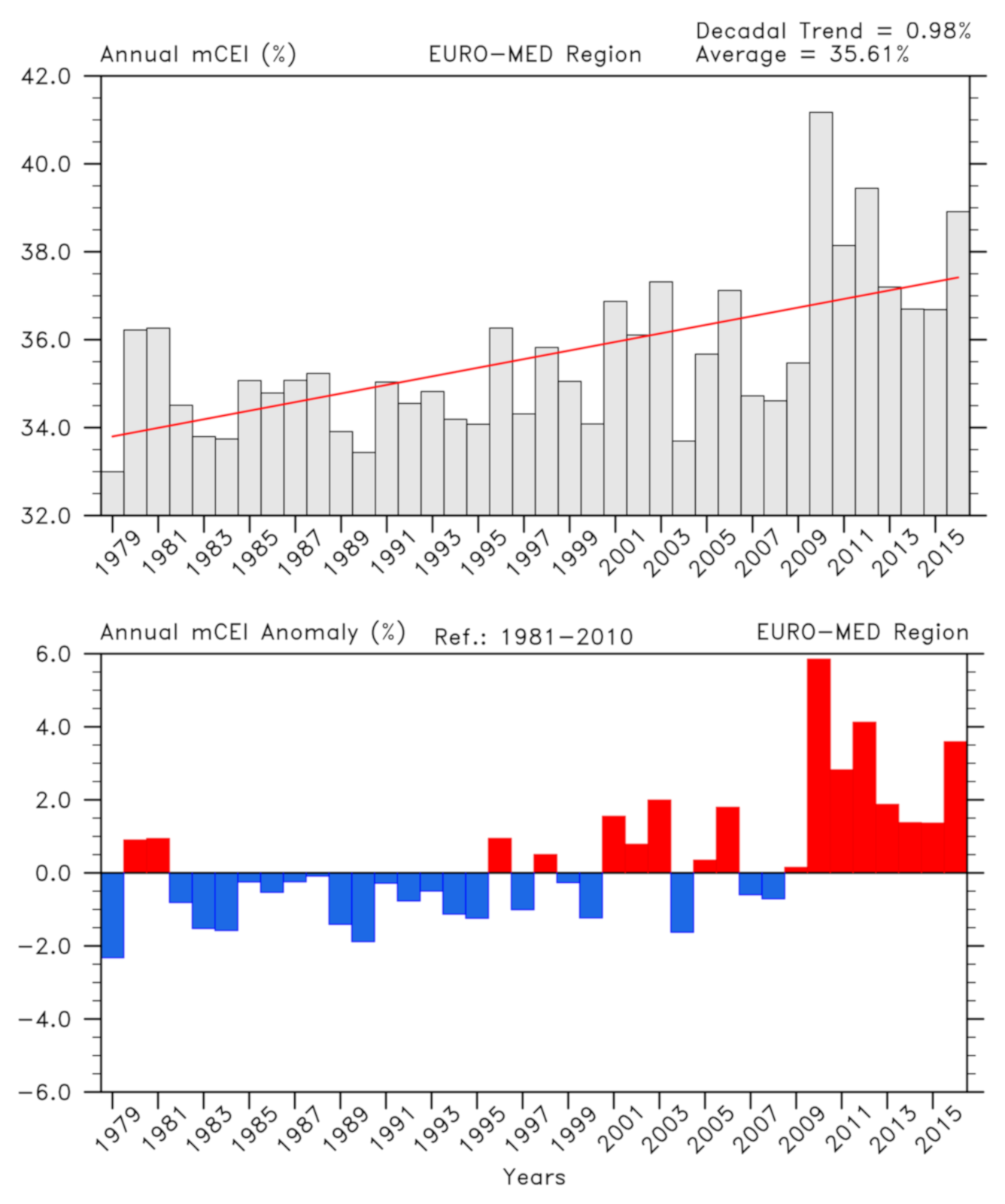
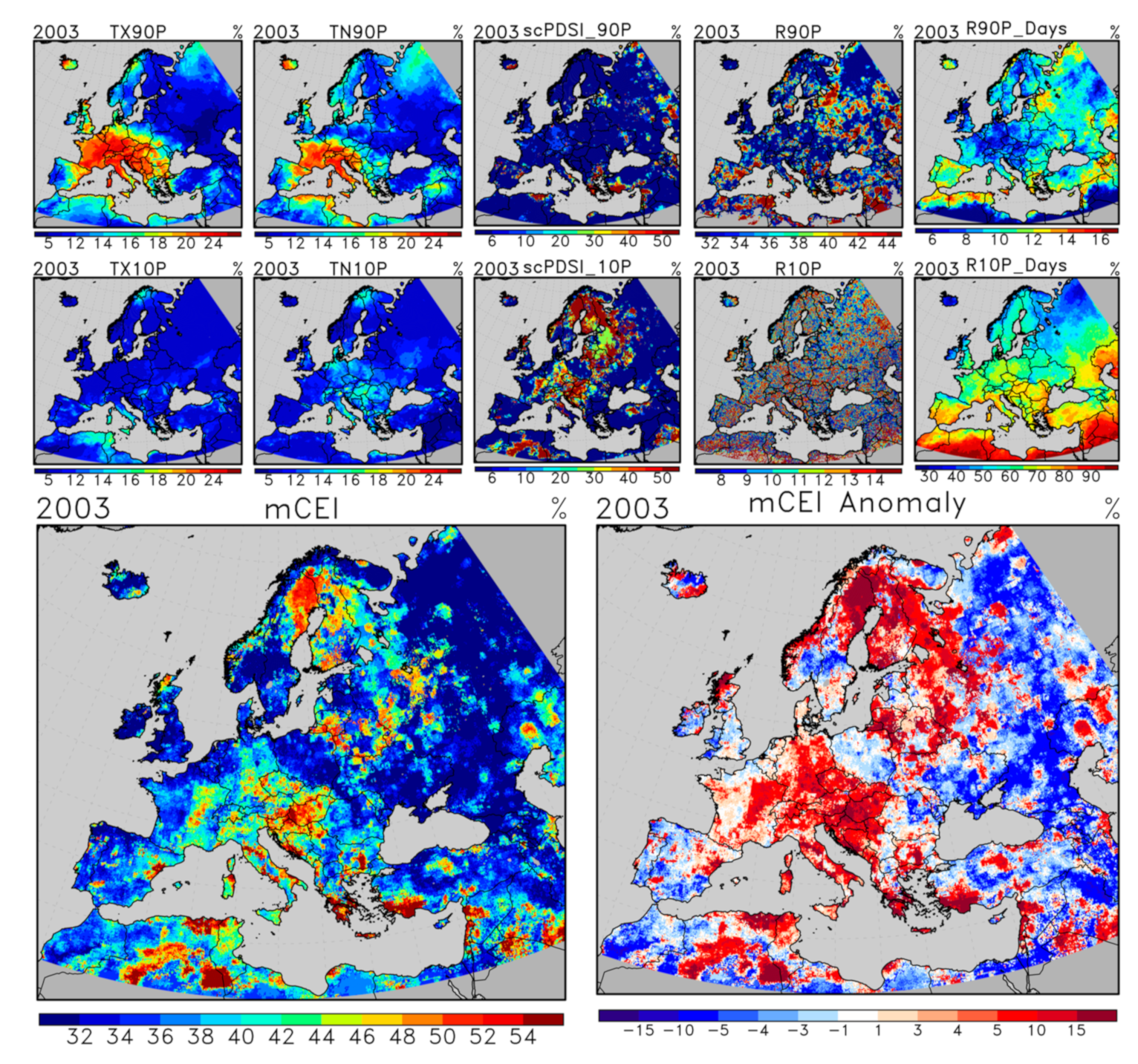
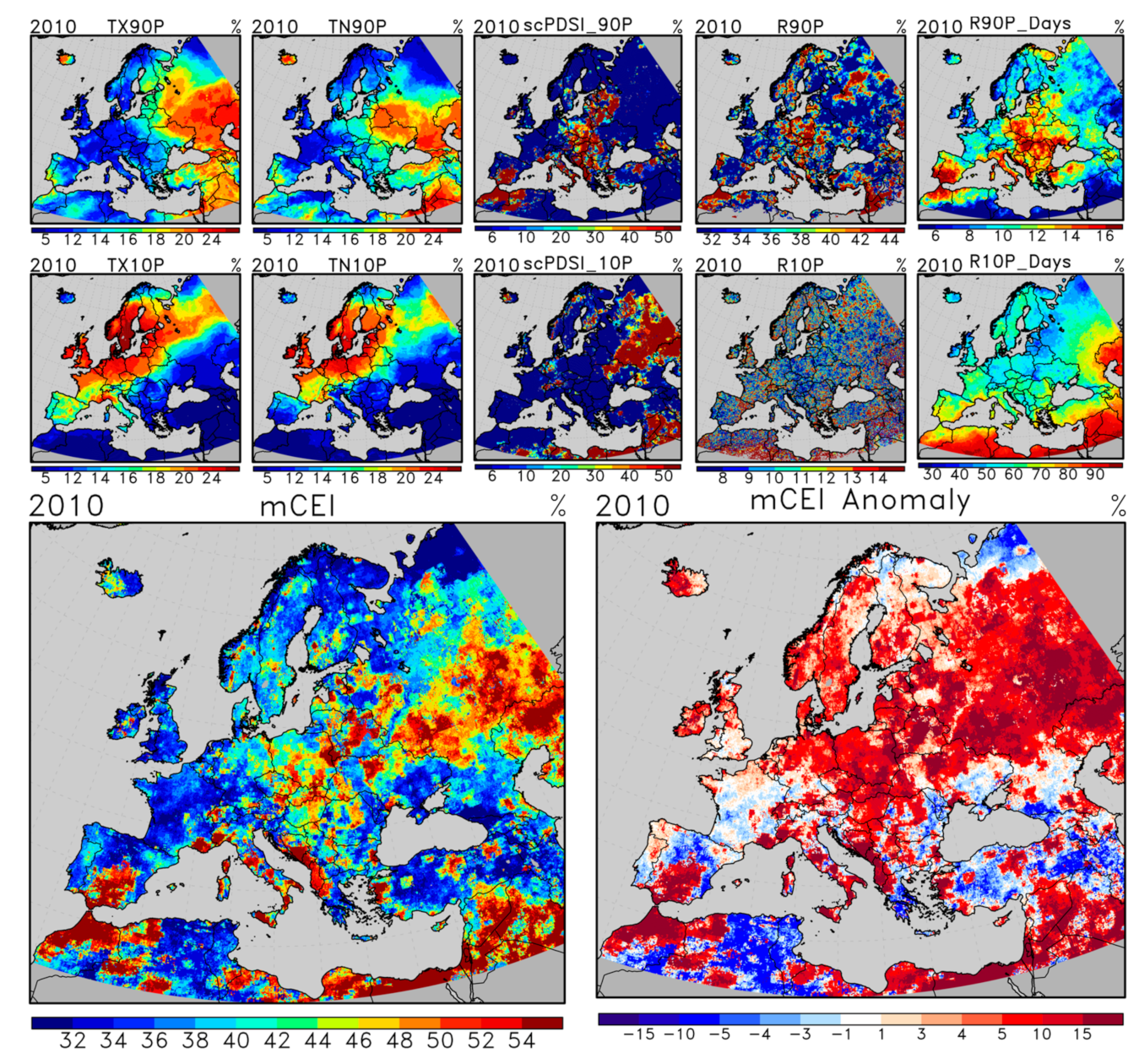
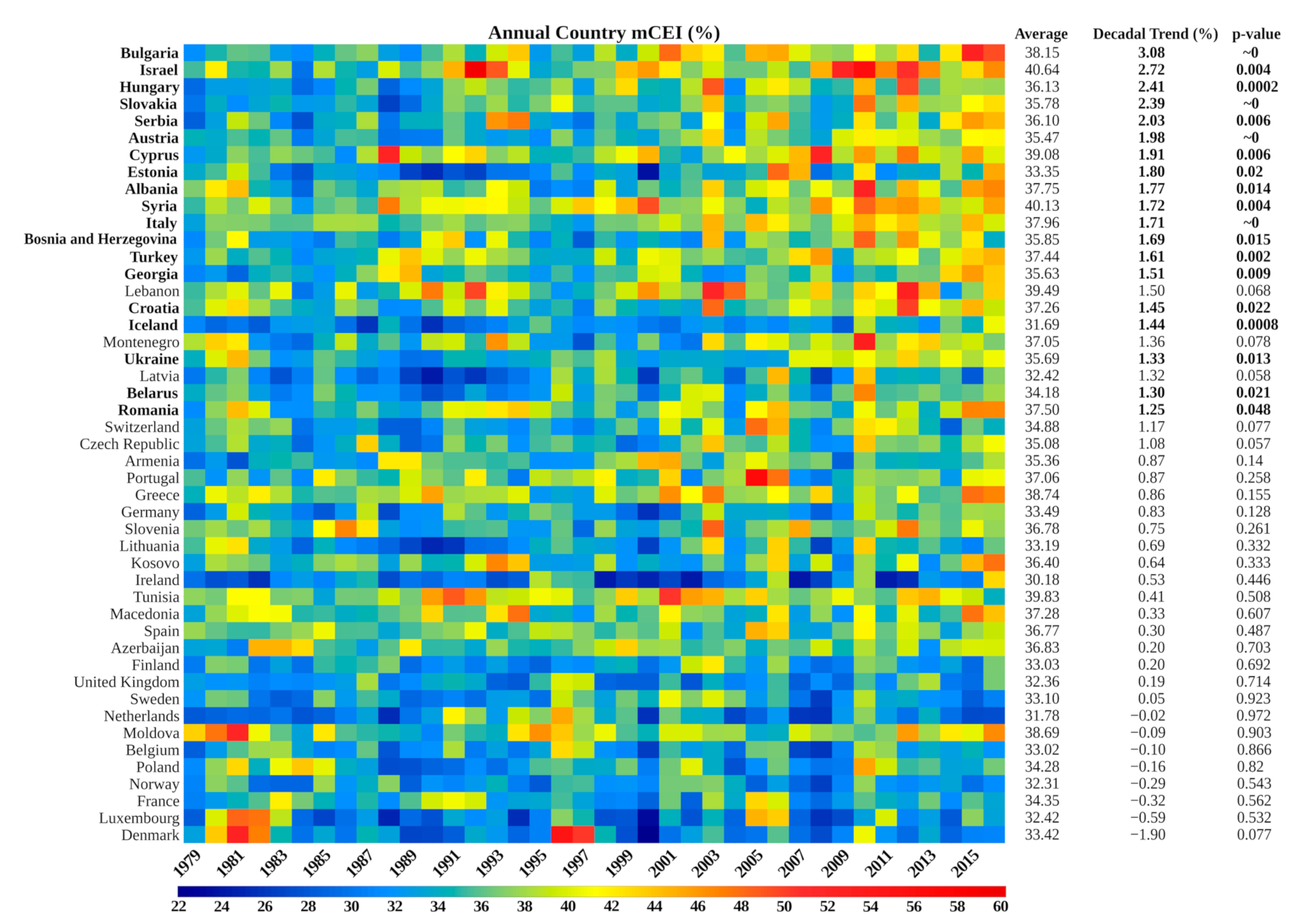
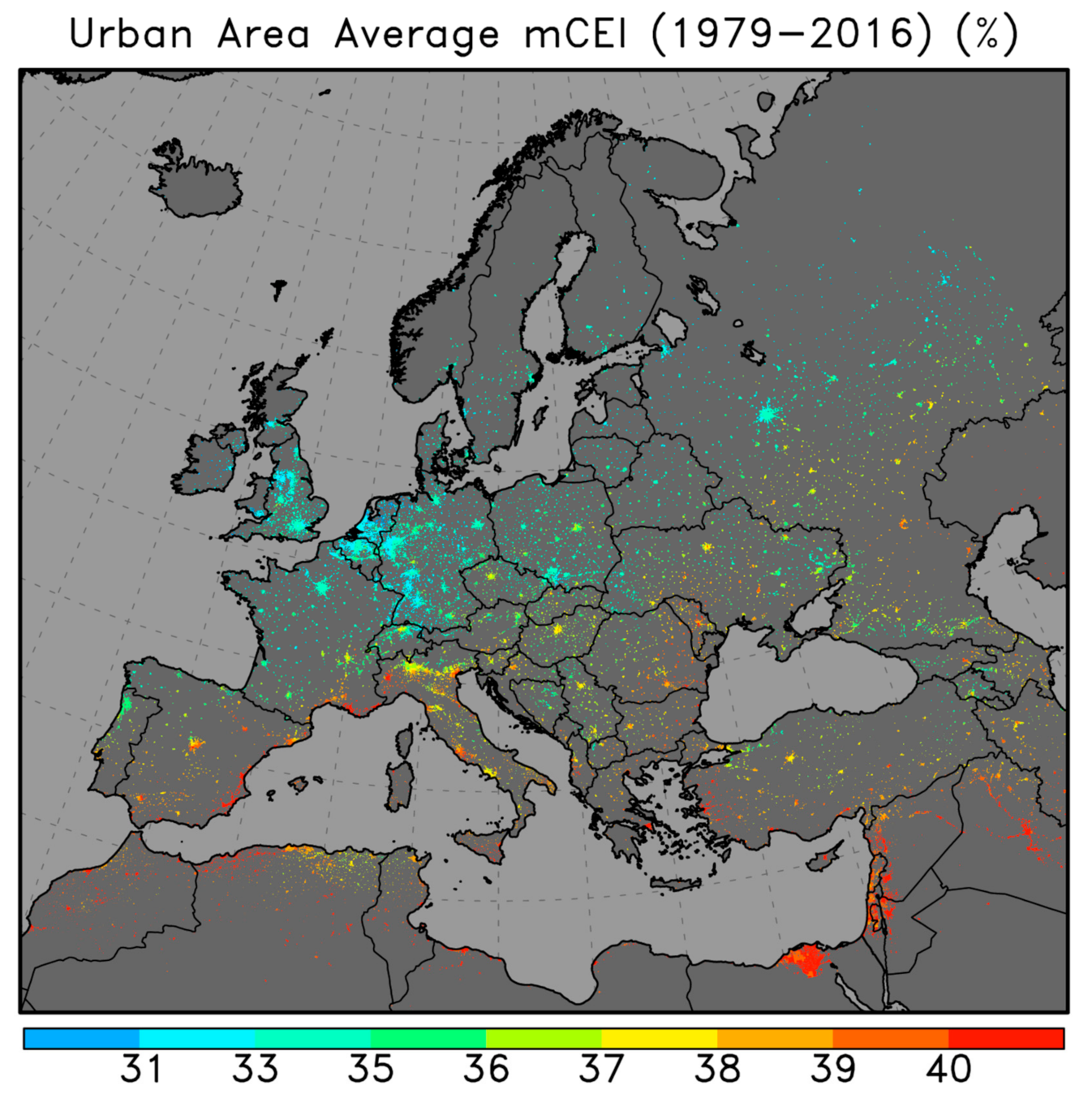

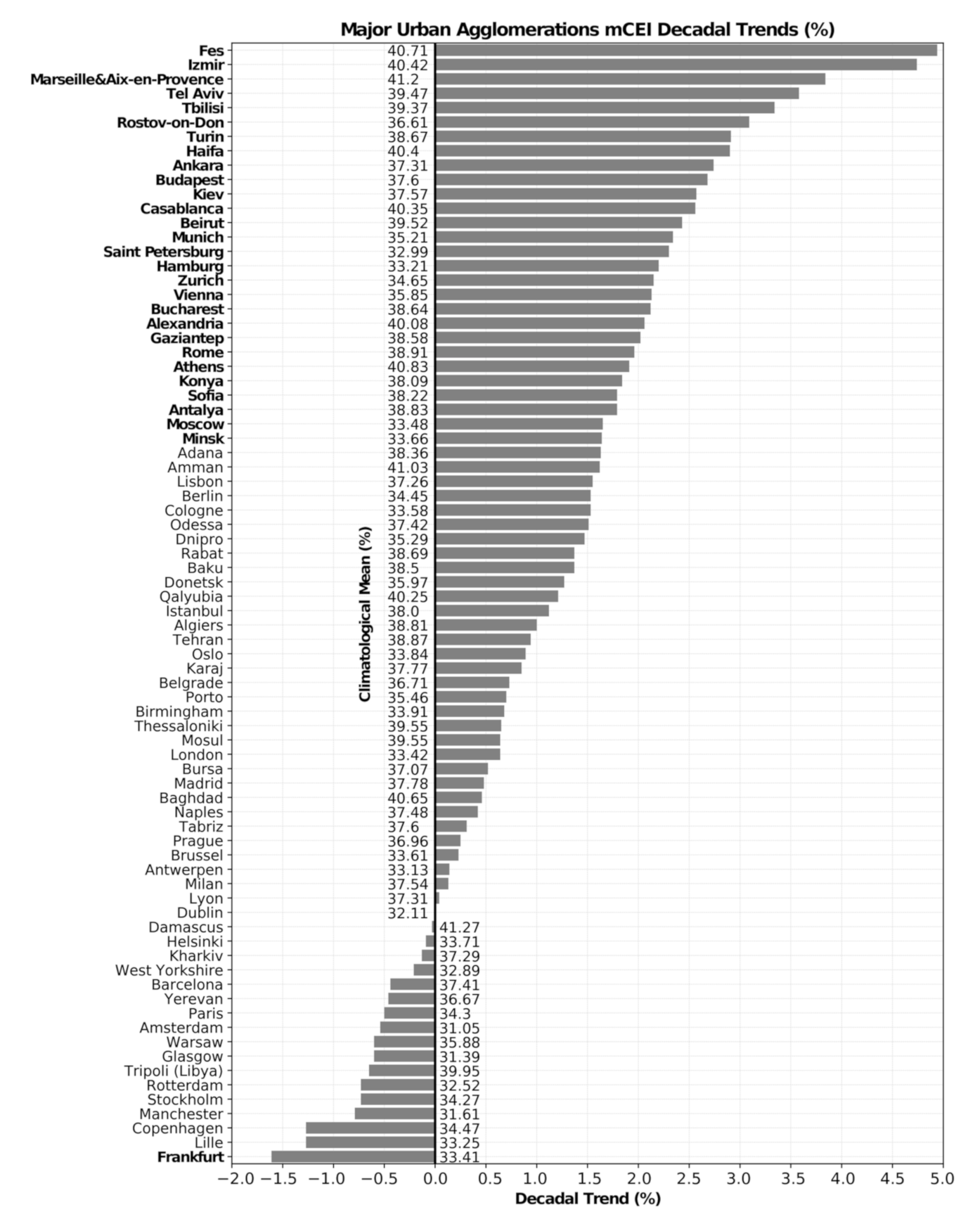
| Extreme Indicators of the Original CEI | Extreme Indicators of mCEI | |
|---|---|---|
| i. | The sum of the fraction of area with maximum temperatures much below normal and the fraction of area with maximum temperatures much above normal. | The sum of the percentage of daily maximum temperatures above the 90th percentile and percentage of daily maximum temperatures below the 10th percentile. |
| ii. | The sum of the fraction of area with minimum temperatures much below normal and the fraction of area with minimum temperatures much above normal. | The sum of the percentage of daily minimum temperatures above the 90th percentile and percentage of daily minimum temperatures below the 10th percentile. |
| iii. | The sum of the fraction of area in severe drought and the fraction of area with severe moisture surplus based on the PDSI. | The sum of the percentage of monthly scPDSI above the 90th percentile and percentage of monthly scPDSI below the 10th percentile. |
| iv. | Twice the value of the fraction of area with a much greater than normal proportion of precipitation derived from extreme (more than 50.8 mm) 1-day precipitation events. | The sum of the percentage of daily precipitation amount above the 90th percentile and percentage of daily precipitation amount below the 10th percentile. |
| v. | The sum of the fraction of area with a much greater than normal number of days with precipitation and the fraction of area with a much greater than normal number of days without precipitation. | The sum of the percentage of days with precipitation above the 90th percentile and percentage of days with precipitation below the 10th percentile (percentage of dry days). |
| Extreme Indicator | Regression Equation | p-Value of the Trend |
|---|---|---|
| TX90P | Y = −375.3237 + 0.1931X | ~0 |
| TX10P | Y = 166.2249 − 0.1284X | 0.0004 |
| TN90P | Y = −324.4909 + 0.1675X | ~0 |
| TN10P | Y = 230.1151 − 0.1102X | 0.002 |
| scPDSI_90P | Y = 146.045 − 0.068X | 0.256 |
| scPDSI_10P | Y = −762.6373 + 0.3863X | ~0 |
| R90P | Y = −29.6738 + 0.031X | 0.034 |
| R10P | Y = 33.8355 − 0.011X | 0.002 |
| R90P_Days | Y = −25.3215 + 0.017X | 0.001 |
| R10P_Days | Y = 61.5985 + 0.0007X | 0.963 |
Publisher’s Note: MDPI stays neutral with regard to jurisdictional claims in published maps and institutional affiliations. |
© 2021 by the authors. Licensee MDPI, Basel, Switzerland. This article is an open access article distributed under the terms and conditions of the Creative Commons Attribution (CC BY) license (https://creativecommons.org/licenses/by/4.0/).
Share and Cite
Kelebek, M.B.; Batibeniz, F.; Önol, B. Exposure Assessment of Climate Extremes over the Europe–Mediterranean Region. Atmosphere 2021, 12, 633. https://doi.org/10.3390/atmos12050633
Kelebek MB, Batibeniz F, Önol B. Exposure Assessment of Climate Extremes over the Europe–Mediterranean Region. Atmosphere. 2021; 12(5):633. https://doi.org/10.3390/atmos12050633
Chicago/Turabian StyleKelebek, Mehmet Barış, Fulden Batibeniz, and Barış Önol. 2021. "Exposure Assessment of Climate Extremes over the Europe–Mediterranean Region" Atmosphere 12, no. 5: 633. https://doi.org/10.3390/atmos12050633
APA StyleKelebek, M. B., Batibeniz, F., & Önol, B. (2021). Exposure Assessment of Climate Extremes over the Europe–Mediterranean Region. Atmosphere, 12(5), 633. https://doi.org/10.3390/atmos12050633





